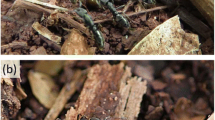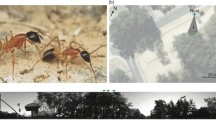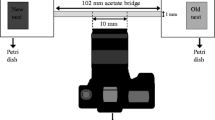Abstract
Social insect colonies exploit food sources that vary in their profitability and riskiness. One factor that affects both profitability and riskiness is the foraging distance: more distant resources are both more costly to exploit and expose individuals to greater predation or navigational risks. Temnothorax nylanderi scouts use tandem running to recruit nestmates to resources, such as food or nest sites. Tandem runs are often unsuccessful, leaving followers in potentially unknown or dangerous territory. Thus, as foraging distances increase, communication mistakes are likely to be more costly. We tested if leaders and followers adjust their tandem running behavior in response to increasing foraging distances. We asked whether the success rate, the probability to recruit, and the waiting time following a loss of contact depend on the foraging distances. We found that the success rate (75–86%) of tandem runs does not decrease with increasing foraging distance but rapidly increases with the leader’s experience, from 67% for the first tandem run to 94% for the fourth. Pairs progressed faster, and followers search longer for their partner after a loss of contact when visiting more distant food sources. The probability to perform a tandem run did not decrease with the foraging distance but increased with foraging experience. Our results indicate that ants might attempt to reduce exposure to risks by progressing faster when visiting more distant food sources. As ants become more experienced, they lead more and better tandem runs. These findings suggest that both leaders and followers respond to the potential dangers posed by exploiting faraway resources.
Significance statement
Foraging distance plays an important ecological role in animals as the foraging distance affects both energetic costs and predation risk. Ants have evolved several cooperative foraging strategies to exploit a food source as efficiently as possible, including a recruitment method called “tandem running.” Here, an informed leader guides a naïve follower to a valuable resource. We tested if tandem running behavior changes if food sources are more distant. Foraging distance indeed had an impact as leaders walked faster and followers searched for longer after a contact loss when food sources were more distant.






Similar content being viewed by others
References
Al Toufailia H, Couvillon MJ, Ratnieks FLW, Grüter C (2013a) Honey bee waggle dance communication: signal meaning and signal noise affect dance follower behaviour. Behav Ecol Sociobiol 67(4):549–556. https://doi.org/10.1007/s00265-012-1474-5
Al Toufailia H, Grüter C, Ratnieks FLW (2013b) Persistence to unrewarding feeding locations by honeybee foragers (Apis mellifera): the effects of experience, resource profitability and season. Ethology 119(12):1096–1106. https://doi.org/10.1111/eth.12170
Basari N, Laird-Hopkins BC, Sendova-Franks AB, Franks NR (2014) Trail laying during tandem-running recruitment in the ant Temnothorax albipennis. Naturwissenschaften 101(7):549–556. https://doi.org/10.1007/s00114-014-1191-1
Beckers R, Goss S, Deneubourg JL, Pasteels JM (1989) Colony size, communication and ant foraging strategy. Psyche A J Entomol 96(3-4):239–256. https://doi.org/10.1155/1989/94279
Beekman M, Sumpter DJ, Ratnieks FL (2001) Phase transition between disordered and ordered foraging in Pharaoh’s ants. Proc Natl Acad Sci U S A 98(17):9703–9706. https://doi.org/10.1073/pnas.161285298
Crawley MJ (2007) The R book. John Wiley & Sons Ltd, West Sussex. https://doi.org/10.1002/9780470515075
Czaczkes TJ, Grüter C, Ratnieks FLW (2015) Trail pheromones: an integrative view of their role in social insect colony organization. Annu Rev Entomol 60(1):581–599. https://doi.org/10.1146/annurev-ento-010814-020627
Detrain C, Deneubourg J-L (2008) Collective decision-making and foraging patterns in ants and honeybees. Adv In Insect Phys 35:123–173. https://doi.org/10.1016/S0065-2806(08)00002-7
Devigne C, Detrain C (2006) How does food distance influence foraging in the ant Lasius niger: the importance of home-range marking. Insect Soc 53(1):46–55. https://doi.org/10.1007/s00040-005-0834-9
Fewell JH, Harrison JF, Stiller TM, Breed MD (1992) Distance effects on resource profitability and recruitment in the giant tropical ant, Paraponera clavata. Oecologia 92(4):542–547. https://doi.org/10.1007/BF00317846
Franklin EL (2014) The journey of tandem running: the twists, turns and what we have learned. Insect Soc 61(1):1–8. https://doi.org/10.1007/s00040-013-0325-3
Franklin EL, Robinson EJH, Marshall JAR et al (2012) Do ants need to be old and experienced to teach? J Exp Biol 215(8):1287–1292. https://doi.org/10.1242/jeb.064618
Franks NR, Richardson T (2006) Teaching in tandem-running ants. Nature 439(7073):153. https://doi.org/10.1038/439153a
Franks NR, Richardson TO, Keir S et al (2010) Ant search strategies after interrupted tandem runs. J Exp Biol 213(6):1697–1954. https://doi.org/10.1242/jeb.087296
Heinze J, Foitzik S, Hippert A, Hölldobler B (1996) Apparent dear-enemy phenomenon and environment-based recognition cues in the ant Leptothorax nylanderi. Ethology 102(3):510–522. https://doi.org/10.1111/j.1439-0310.1996.tb01143.x
Hingston R (1929) Instinct and intelligence. Macmillan, New York
Hölldobler B, Engel H (1978) Tergal and sternal glands in ants. Psyche (Stuttg) 85(4):285–330. https://doi.org/10.1155/1978/23867
Hölldobler B, Möglich M, Maschwitz U (1974) Communication by tandem running in the ant Camponotus sericeus. J Comp Physiol 90(2):105–127. https://doi.org/10.1007/BF00694481
Hölldobler B, Traniello J (1980) Tandem running pheromone in ponerine ants. Naturwissenschaften 67(7):360. https://doi.org/10.1007/BF01106596
Hölldobler B, Wilson EO (1990) The ants. Harvard University Press, Springer, Berlin. https://doi.org/10.1007/978-3-662-10306-7
Kaur R, Joseph J, Anoop K, Sumana A (2017) Characterization of recruitment through tandem running in an Indian queenless ant Diacamma indicum. R Soc Open Sci 4(1):160476. https://doi.org/10.1098/rsos.160476
Lanan MC (2014) Spatiotemporal resource distribution and foraging strategies of ants (Hymenoptera: Formicidae). Myrmecological News 20:53–70. https://doi.org/10.1016/j.biotechadv.2011.08.021.Secreted
Mallon EB, Pratt SC, Franks NR (2001) Individual and collective decision-making during nest site selection by the ant Leptothorax albipennis. Behav Ecol Sociobiol 50(4):352–359. https://doi.org/10.1007/s002650100377
Möglich M, Maschwitz U, Hölldobler B (1974) Tandem calling: a new kind of signal in ant communication. Science 186(4168):1046–1047. https://doi.org/10.1126/science.186.4168.1046
O’Shea-Wheller TA, Sendova-Franks AB, Franks NR (2016) Migration control: a distance compensation strategy in ants. Sci Nat 103(7-8):66. https://doi.org/10.1007/s00114-016-1386-8
Planqué R, van den Berg JB, Franks NR (2010) Recruitment strategies and colony size in ants. PLoS One 5(8):1–8. https://doi.org/10.1371/journal.pone.0011664
Pratt SC (2008) Efficiency and regulation of recruitment during colony emigration by the ant Temnothorax curvispinosus. Behav Ecol Sociobiol 62(8):1369–1376. https://doi.org/10.1007/s00265-008-0565-9
Richardson TO, Sleeman PA, McNamara JM et al (2007) Teaching with evaluation in ants. Curr Biol 17(17):1520–1526. https://doi.org/10.1016/j.cub.2007.08.032
Roces F (1990) Leaf-cutting ants cut fragment sizes in relation to the distance from the nest. Anim Behav 40(6):1181–1183. https://doi.org/10.1016/S0003-3472(05)80185-X
Schultheiss P, Raderschall CA, Narendra A (2015) Follower ants in a tandem pair are not always naïve. Sci Rep 5(1):10747. https://doi.org/10.1038/srep10747
Shaffer Z, Sasaki T, Pratt SC (2013) Linear recruitment leads to allocation and flexibility in collective foraging by ants. Anim Behav 86(5):967–975. https://doi.org/10.1016/j.anbehav.2013.08.014
Stuttard JP, Gottlieb D, Franks NR (2016) Ants incommunicado: collective decision-making over new nest sites by ants with reduced communication. Behav Ecol Sociobiol 70(1):145–155. https://doi.org/10.1007/s00265-015-2033-7
Taylor F (1977) Foraging behavior of ants: experiments with two species of myrmecine ants. Behav Ecol Sociobiol 2(2):147–167. https://doi.org/10.1007/BF00361899
Traniello JFA (1989a) Foraging strategies of ants. Annu Rev Entomol 34(1):191–210. https://doi.org/10.1146/annurev.ento.34.1.191
Traniello JFA (1989b) Chemical trail systems, orientation, and territorial interactions in the ant Lasius neoniger. J Insect Behav 2(3):339–354. https://doi.org/10.1007/BF01068060
Traniello JFA, Hölldobler B (1984) Chemical communication during tandem running in Pachyconcyla obscuricornis (Hymenoptera: Formicidae). J Chem Ecol 10(5):783–794. https://doi.org/10.1007/BF00988543
von Frisch K (1967) The dance language and orientation of bees. Harvard University Press, Cambridge
Wilson EO (1959) Communication by tandem running in the ant genus Cardiocondyla. Psyche: A Journal of Entomology 66(3):29–34. https://doi.org/10.1155/1959/29093
Zuur A, Ieno E, Walker N et al (2009) Mixed effects models and extensions in ecology with R. Springer, New York. https://doi.org/10.1007/978-0-387-87458-6
Acknowledgements
We thank Stephen Pratt and an anonymous referee for their valuable and helpful comments on the manuscript. This study was supported by the Deutsche Forschungsgemeinschaft (DFG) (GR 4986/1-1).
Author information
Authors and Affiliations
Corresponding author
Additional information
Communicated by William Hughes
Electronic supplementary material
Fig. S1
(DOCX 554 kb)
Rights and permissions
About this article
Cite this article
Glaser, S., Grüter, C. Ants (Temnothorax nylanderi) adjust tandem running when food source distance exposes them to greater risks. Behav Ecol Sociobiol 72, 40 (2018). https://doi.org/10.1007/s00265-018-2453-2
Received:
Revised:
Accepted:
Published:
DOI: https://doi.org/10.1007/s00265-018-2453-2




